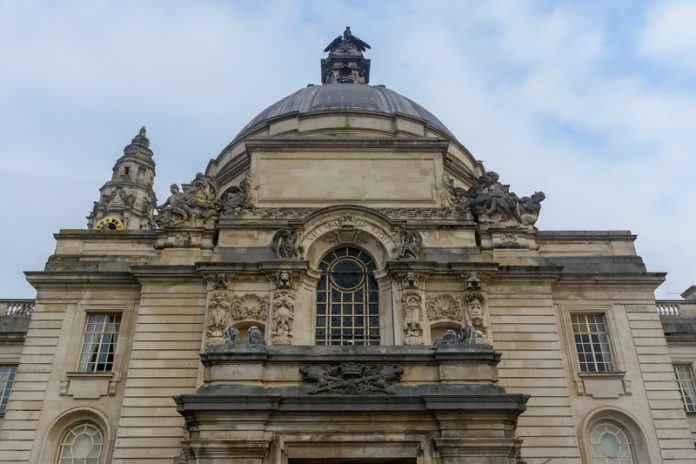The Victorian Society’s 2018 list of the most endangered Victorian and Edwardian buildings in the UK highlights a diverse collection of striking, historically important structures in need of urgent care
Each year since 2007, the Victorian Society has run a campaign called the Top 10 Endangered Buildings list. It’s fairly self-explanatory: in September we release a list of the top 10 most endangered Victorian and Edwardian buildings in the UK. The risk that these buildings face could be one of many things: often it is just general neglect, from showing signs of decay to literally almost falling down, but other times it can be the threat of insensitive development or even demolition.
The top 10 is chosen in-house by our team of conservation experts, but it is shortlisted from a selection of nominations by the general public. This is, I think, the most interesting and valuable part of the top 10 campaign: it starts and ends with people as well as buildings. Every year, we ask the general public to nominate buildings in their area that they are concerned about, and we consider each case we are sent (whether that building has been nominated once or a dozen times) and shortlist the final top 10 from the selection.
Without the support we get from the general public, the campaign would not be able to exist. Though we are a national charity, we cannot possibly know about every endangered Victorian building in the UK. There will inevitably be some that fall beneath our radar, often serious cases of important buildings at risk.
All of the buildings in this year’s top 10 list are Grade II listed or higher, which means they have been identified by Historic England as historic buildings of importance. A lot of people say to us, “well you can’t possibly protect every threatened Victorian building in the UK”, but this list demonstrates that even the most important ones, ones that have been singled out and honoured for their historic and/or architectural importance, are still very much susceptible to risk.
As for this year’s final list, it’s a particularly exciting one. It’s been many years since we have had such an eclectic selection of buildings, each with its own unusual story to tell. The 2018 top 10 list includes a seaside winter gardens which was built in Torquay and then transported piece-by-piece to Great Yarmouth in 1904; an ex-ballet school which was originally a girls’ orphanage and then a boys’ seminary, but is probably most famous as the Jameah Islamic school, which was raided by Metropolitan Police in 2006; and a whole Victorian village in Liverpool, which was built by philanthropist and businessman Sir William Hartley to house the workers of his pioneering jam factory.
Christopher Costelloe, director of the Victorian Society, said: “This year’s list in particular demonstrates that all sorts of historic buildings can become at-risk, no matter where they are or what use they were built for. It is also a perfect selection to show the myriad of Victorian and Edwardian buildings we have here in the UK.
“When many people think of 19th century architecture, they think of red-brick, nouveau gothic structures, and while much of our Victorian architecture does adhere to that style, the Victorians were also great industrialists and built great brick factories and iron gasholders which are equally worthy of protection and celebration.”
The Victorian Society’s Top 10 Endangered Buildings campaign is so important because it highlights the plight of endangered Victorian buildings and brings their suffering to a national audience. In the 10 years that we have been running this campaign, we have seen buildings featured become transformed by funding grants, new owners and/or new investors, and that is our hope for this year’s list: that by bringing them forward into the public eye we improve their futures.
The Top 10 Endangered List
The Winter Gardens, Great Yarmouth (Grade II, 1878-81, John Watson & William Harvey)

Incredibly, this striking glass and iron structure was originally designed and constructed in Torquay and then relocated by barge all the way to its current position in Great Yarmouth in 1904, reportedly without a single pane of glass breaking.
Over the years, it has been used as a ballroom, roller-skating rink and even a German beer garden, but now sits empty. Great Yarmouth Borough Council is actively looking for an investor to bring this unique, nationally important building back into use.
Bromley-by-Bow gasholders, London (All Grade II, 1872, Clark & Kirkham)
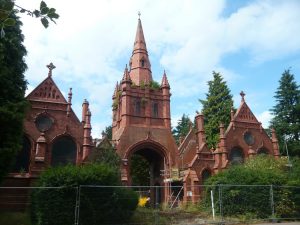
This patch of seven gasholders (the eighth was destroyed by a bomb in WW2) in east London is surrounded by industrial development but the gasholders have been unused for decades. They are best viewed as an imposing group from the train as the tracks run just alongside, though the intricate detail of the ironwork can only be appreciated up close. The group value of so many Victorian gasholders packed together is unmatched anywhere else in the world, making the Bromley-by-Bow gasholders a true symbol for the Industrial Revolution.
Merseyside Centre for the Deaf, Liverpool (Grade II, 1887, EH Banner)
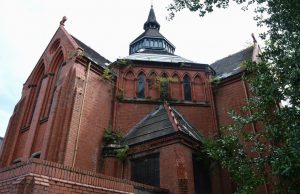
Initially built as a chapel for the Merseyside deaf community, this once-grand gothic structure is in a terrible state. For 20 years after its closure in 1986 it was run as a successful community centre for the Igbo community, but rising costs and an aging membership forced them out in 2007 and it has been closed ever since. The community are full of ideas for its transformation, but its current severe condition means urgent works are desperately needed first for its repair and to secure it from further damage.
Hartley’s Village, Aintree, Liverpool (three Grade II listed buildings, 1886-95, architect unknown)
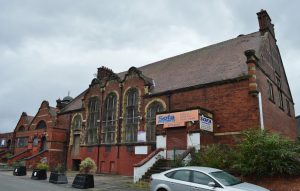
Still famous as a popular brand of jam, this site is named for the former Hartley’s factory that once stood here. Founder Sir William Hartley built an entire village of 49 houses for his workers and in 2011 the whole site was declared a Conservation Area. While the houses have enjoyed successful reuse, the remaining listed factory buildings (the main factory building was demolished in the early 20th century) have been neglected and are now largely derelict. This important piece of Liverpool’s industrial and philanthropic heritage deserves to be protected, restored and celebrated
Former Legat’s School of Ballet, nr Rotherfield, East Sussex (Grade II, 1865, exterior: George Goldie, interior: EW Pugin)
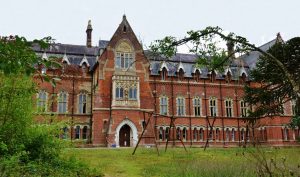
Hidden by thick woodland on all sides, this handsome Victorian mansion was built as a girls’ orphanage and until recently its most famous incarnation was as a ballet school from 1970-90. But in the early 1990s, it was bought by a charity and run as an Islamic school, before it was raided by police in 2006 on the suspicion that it was being used as a training camp for terrorists. Since the school closed in 2007, it has remained unused and is beginning to show signs of disrepair. It is a beautiful building in large grounds and has amazing potential for reuse.
Oldway Mansion, Paignton, Devon (Grade II, 1873, GS Bridgman)
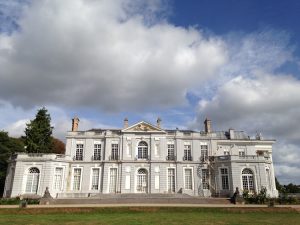
Built as the private residence of American inventor Isaac Singer, this mansion was drastically remodelled by his son in the early 20th century in the style of the Palace of Versailles. The interiors are just as opulent, with an imperial staircase leading up to a ballroom on the east side and a gallery based on the hall of mirrors at Versailles on the west. It was used as council offices from 1946 until 2007, when the council announced its intention to sell the building. Now its future is uncertain, though the community feel strongly that it should remain as a public space.
John Summers Steelworks, Shotton, Wales (Grade II, 1907, James France)
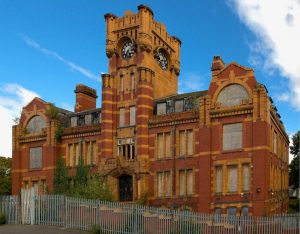
This former office building of the John Summers Steelworks stands proudly on the banks of the River Dee, but its highly industrial location has made its reuse complicated and, thus far, unsuccessful. To make matters worse, the building is subject to regular break-ins and vandalism and is now in a poor state of repair. Developers are in ownership of such a striking building, which encapsulates the proud industrial heritage of the area; surely they can come up with a new reuse that showcases the building’s architectural significance in a creative and sensitive way?
Langley Maltings, Sandwell, West Midlands (Grade II, 1870, architect unknown)
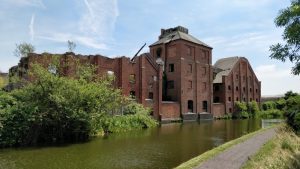
These prominent maltings on the banks of the Titford Canal were saved from demolition in 2012 but with no current proposals for repair and reuse, they have fallen into a very bad state. Built in 1870 as Showells Maltings, they were in use until 2006 but were victims of arson in 2009, which caused significant damage. The attractive design and prime location make them ideal for development; they just need the right developer.
Brandwood End Cemetery Chapels, Birmingham (Grade II, 1898, J Brewill Holmes)
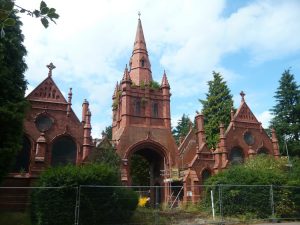
These red brick, neo-gothic mortuary chapels stand at the highest point of Brandwood cemetery grounds and provide a dramatic central focus for the cemetery. But drama that should be evoked by the striking symmetrical design is in fact compounded by the terrible state they are in. Closed for over 30 years, they suffered a serious arson attack in 1995, which gutted the north-east chapel. A Friends group was set up in 2005 and several years later plans were underway to be part of a joint bid with Birmingham City Council and the Heritage Lottery Fund for funding to restore the chapels; but in 2012, the newly elected BCC unfortunately withdrew from the project, citing austerity measures.
St Mary’s Convent Church, Leeds (Grade II, 1852, Joseph Hansom & W Wardell, chancel & transepts added 1866 by EW Pugin)
In a disused plot of land just outside central Leeds, this imposing Grade II listed church is a sight to behold. Closed as a church for almost 30 years, it has had various planning applications attached to it – including an approved residential conversion scheme in 2007 – but nothing has come to fruition. Urban explorer photographs show very dilapidated interiors, though much of the detailing and stained glass seems to have survived. Such a beautiful building in a prominent location deserves much more than being left to rot.
Harriet Lawrence
Media Officer
The Victorian Society
Tel: +44 (0)208 994 1019
https://www.facebook.com/thevicsoc/
https://www.instagram.com/thevicsoc/


